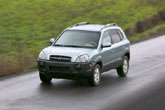Recent Articles
Popular Makes
Body Types
2005 Hyundai Tucson
Useful utility, plentiful features
PORTLAND, OR – With dramatic gains in quality, competitive vehicle designs, and one of the industry’s best power train warranties, Hyundai is finally coming into its own. Recent awards for quality and value have put Hyundai on consumers’ radar in record numbers. In fact, Hyundai is now the fourth best-selling import brand in the U.S., and the addition of vehicles such as the 2005 Tucson point the way to continued success. Hyundai’s new 2005 Tucson, in fact, is the first volley of a massive product offensive. On sale now, the Tucson is a small SUV designed to compete with the Ford Escape, Honda CR-V, and Toyota RAV-4. Hyundai expects to sell about 40,000 Tucsons next year, and after a day of driving the new SUV on the city streets, freeways, mountain roads, and coastal routes in and near Portland, Ore., we’re convinced that the company is poised to continue winning customers and critical acclaim.
Page 2: Competitor
Based upon a heavily modified Elantra platform, the Tucson has a longer wheelbase, shorter length, and greater width than its key competitors. Lighter than the Escape and the CR-V, the 2005 Hyundai Tucson also features more front leg room than those two models, and exceeds both the Escape and RAV-4 in terms of rear seat leg room. Other interior dimensions stack up competitively, including cargo space, which measures 22.7 cubic feet with the rear seat raised and 65.5 cubic feet with the rear seat lowered. Hyundai sells the Tucson in three well-equipped trim levels: GL, GLS, and LX. All Tucsons come with front side-impact airbags, side-curtain airbags for the front and rear occupants, a stability control system, a traction control system, and antilock brakes. In fact, the 2005 Hyundai Tucson is the least expensive vehicle equipped with side-curtain airbags and stability control.
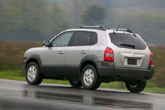
Page 3: Equipment
Additional standard equipment on the GL includes handsome 16-inch alloy wheels; air conditioning; power windows, mirrors and door locks with remote keyless entry; heated outside mirrors; a CD player with six speakers; privacy glass; a rear wiper; and floor mats. Pricing for the Tucson GL is $17,499 plus a $595 destination charge. Powering the 2005 Hyundai Tucson GL is a 2.0-liter inline four-cylinder engine equipped with variable valve timing. It generates 140 horsepower at 6,000 rpm and 136 lb.-ft. of torque at 4,500 rpm, with a five-speed manual transmission delivering motive force to the front wheels. Fuel economy is rated 22-mpg in the city and 27-mpg on the highway, dropping to 21/26 for four-wheel-drive models. Options for the Tucson GL are an $800 four-speed automatic transmission and a $1,500 Borg-Warner Electronic InterActive Torque Management 4WD system that adds 185 pounds to the GL’s 3,240-pound base curb weight. When equipped with 4WD, the front wheels receive 99 percent of the engine’s output under normal driving conditions. Wheel slippage causes power to be automatically diverted to the rear wheels, and a button on the dashboard allows the driver to manually lock the driveline into a 50/50 continuous power split. There is no low range gearing for serious rock hopping, making the Tucson adept only at covering well-worn trails without serious hills or battling heavy snowfall in urban areas. Sensibly, 4WD is only available with the manual transmission when paired to the four-cylinder engine, making the most expensive Tucson GL a $19,600 proposition.
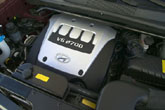
Page 4: Trims
Hyundai expects the Tucson GLS to be the most popular model, with a standard 2.7-liter V6 engine making 173 horsepower at 6,000 rpm and 178 lb.-ft. of torque at 4,000 rpm. It’s mated to a four-speed automatic that drives the front or all four wheels, getting fuel economy of 20-mpg city and 26-mpg highway in standard guise or 19/24 with 4WD. Sadly, because it would be nice to save several hundred dollars, a manual transmission is not available on the GLS. What is available on the Tucson GLS is a unique set of alloy wheels wrapped with 245/60R16 B.F. Goodrich Traction T/A tires; gray side cladding and bumpers; body-colored door handles and outside mirrors; a chrome rear tailgate garnish; fog lights; a leather-wrapped steering wheel and shift knob; metallic interior trim; door courtesy lights; an illuminated ignition surround; a luggage net; and a heated wiper rest for $19,999 plus the destination charge. Factory options include the 4WD system and a package that includes a power sunroof and an upgraded audio system with a six-disc in-dash CD changer and a subwoofer. At the top of the lineup is the Tucson LX, which is just like the GLS but adds perforated leather upholstery, heated front seats, and an in-dash CD changer with a subwoofer. For the LX, 4WD and a power sunroof package are the only factory options. Pricing for the LX is $21,249 plus destination. A loaded 2005 Hyundai Tucson LX costs about $23,500.
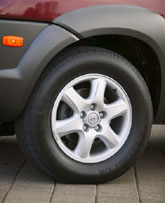
Page 5: Driving
We spent several hours as pilot and passenger inside a 2005 Hyundai Tucson GLS 4WD equipped with the power sunroof and upgraded audio system. With good power off the line, the 2.7-liter V6 engine is fine for bopping around town, and we found the Tucson to be neither under or overpowered with two adults and a couple of bags on board when passing on two lane roads. The spry little sport-ute could effortlessly cruise at highway speeds, and crested the Cascade Mountains without breaking a sweat as we made our way from Portland to the Pacific. Under hard acceleration, the Tucson seemed to deliver more thrash than thrust, but since most people won’t drive it with the pedal to metal, this is unlikely to cause irritation. Based on our initial drive, the 2.7-liter V6 is exactly right for the Tucson; we’d guess buyers of the GL model might wish they’d spent a little extra to get the bigger engine. Supporting the engine’s adequate performance is an automatic transmission that shifts smoothly in automatic mode and responsively in manual mode. Shifting manually is easy, with a separate gate that allows a tap of the gear selector up for the next higher gear and a tap down for the next lower gear. Again, under hard acceleration, the transmission upshifts slowly and softly, which underscores the obvious fact that you shouldn’t buy a Tucson for drag racing.

Page 6: Off-road
Neither should you buy a Tucson for serious off-roading. Without a low-range transfer case, the Tucson is meant to travel only well worn trails through the woods, like the utility access road Hyundai had us drive in the forest just east of Tillamook, Ore. With lots of mudholes but few significant bumps, dips, hills, or ruts, this trail posed little challenge for the Tucson, which bounded through without bottoming thanks to 7.8 inches of ground clearance. We did detect a delay in power transfer when the front wheels slipped in the muck, but Hyundai never claimed that the 4WD system would operate transparently to the driver. Besides, there’s a way to lock the driveline into a 50/50 split by using a simple button on the dashboard if you’re not interested in leaving power transfer to the system’s electronic brain. Later, on a wet dirt road, we sawed at the Tucson’s steering wheel to engage the stability control system. It exhibited a high threshold of slip before engagement, working effectively and unobtrusively to get the Tucson under control once activated. On pavement, the 2005 Hyundai Tucson’s power rack-and-pinion steering has a bit of play on center and requires more muscle to twist than expected, but offers a decent feel for the road. With MacPherson struts up front and a multi-link arrangement in back, the four-wheel-independent suspension provides an impressive ride and handling mix. Driving harder than most people might, we found that the Tucson’s weight transitions well between corners, and that it’s easy to drive this SUV with spirit, if not verve. Even the brakes work well, with a pedal that’s easy to modulate for squeezing just the right amount of pressure to the calipers. They aren’t touchy or grabby, and there’s no excessive pedal travel.
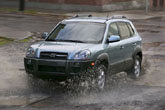
Page 7: Interior
While competent hardware under the sheet metal is always important, what can make or break a vehicle is the interior, where the owner and passengers spend all their time. Here, Hyundai once again proves itself competitive, thanks to plenty of space for four adults, quality materials, and first-rate construction. If only the seat foam had a little more long-distance spring to it. Over time, the seats get hard like those square cushions people use on bleachers at high school football games, making the Tucson less comfortable than it seemed at first. Despite this, we cannot quibble with the fact that the front seats offer manual height and tilt adjustment, which combines with plenty of seat track travel and a tilt steering column to help create a proper driving position. Folks who like to rest an elbow on the upper door panel will want to know that these are hard plastic in the Tucson, but the leather covering the steering wheel is soft and nice to grip, and the center console is height adjustable to help maximize comfort. Four tall people can ride in the 2005 Hyundai Tucson. In back, the seat cushion was mounted too low to provide good thigh support, and there is adequate legroom and plenty of foot room under the front seats. The seat backs recline, and there’s a handy fold down center armrest with cupholders molded right in. Here again, as with the front seats, the biggest obstacle to comfort was mushy seat padding that felt firm and supportive at first but degenerated over time.
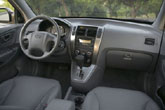
Page 8: Cargo
The 2005 Hyundai Tucson excels when it comes to carrying cargo. Load the composite-lined cargo floor and rear seatbacks through the liftgate or a handy flip-up rear window. The rear seats fold in a 60/40 split from either the rear of the Tucson or through the rear side doors by lifting the releases located on the upper outboard part of the seatbacks next to the headrests, which don’t require removal to create a flat load floor. To expand capacity, the front passenger’s seat can also be folded flat. A rear cargo mat helps limit spills, but if some kind of goo does drip all over, the cargo floor can be removed from the Tucson for cleaning. Other useful features of the cargo area include grocery bag holders, underfloor storage, six tie-downs, a 12-volt outlet, a cargo light, a netted cargo pocket, a cargo net, and a cargo cover with storage trays molded into the top. The 2005 Hyundai Tucson is designed with handy and thoughtful storage spaces throughout, from the innovative trays under the armrests on the doors to the dished bin atop the center of the dashboard. The visor vanity mirror covers have cardholders molded into them, there are bins in each of the four door panels, and several spots are lined with felt or rubber to provide additional grip or to reduce noise, vibration and harshness (NVH). Determining if the 2005 Hyundai Tucson’s interior was quiet proved difficult on Portland’s roadways, which are chewed up by the use of studded snow tires. But on one long stretch of relatively new blacktop, we got our answer. Front and rear seat riders can converse in normal tones of voice at highway speeds. Not only is the Tucson relatively quiet inside, it’s also free of rattles and squeaks thanks to outstanding build quality.
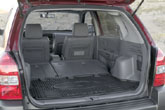
Page 9: Quality
Try as we might, we could not pull or prod any of the Tucson’s interior bits and pieces loose of their moorings. This Hyundai is well assembled. And the quality of the materials is high, too. Take, for instance, the headliner, which is plush cloth mostly free of lint and fuzz. Proof that Hyundai spent time and money getting the details right is in how the headliner meets the sunroof. Instead of a rubber gasket surrounding the sunroof opening to hide the unfinished edge of the headliner, Hyundai has chosen to go the extra step of wrapping the headliner around the lip of the sunroof opening, and adhering it to the roof. That’s how luxury car builders solve this problem, and Hyundai is supplying it on an entry-level SUV priced just above $20,000. Something else that reminded us of a luxury car was the Tucson’s buttons and controls. Everything operates with the fluidic heft of a Lexus, and at night, Hyundai has seen fit to make sure all of the controls on the door panel are illuminated, not just the driver’s window. Other signs that the company didn’t chintz to eke extra profit out of the Tucson include slick cargo shade extensions that clip onto the headrest supports that allow the seat to recline while protecting valuable from prying eyes; one-touch open control for the power sunroof; and 12-volt power outlets for the front seats, the rear seats, and the cargo area.
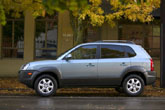
Page 10: Exterior
While exterior design is rugged yet contemporary, the Tucson is slightly out of balance up front. The wheels should be closer to the front corners the way the rear wheels are placed right at the ends of the fenders, and the fog lights moved lower in the bumper. As it stands, the Tucson has too much nose and chin. Inside the GLS, the psychedelic geometric pattern of the cloth seat and door inserts draws far too much attention to itself, creating a jarring appearance in what is otherwise a tastefully executed cabin. The simple cloth of the GL and perforated leather of the LX are superior to the cloth found in the GLS. So the future looks good for the Tucson. Dynamically, the 2005 Hyundai Tucson cannot distinguish itself from the pack of small suvs currently on the market. It drives no better and no worse than the class average. Rather, the new Tucson’s strengths are a full complement of standard safety features, a great powertrain warranty, a small size combined with useful utility, and a low price tag. If these features are important to you, and you like what you see, you should test drive the Hyundai Tucson.
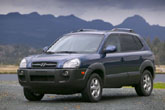
Page 11: FAQs
How does the Tucson stack up against the competition? The Tucson has a longer wheelbase, shorter length, and greater width than its key competitors. Lighter than the Escape and the CR-V, the 2005 Hyundai Tucson also features more front leg room than those two models, and exceeds both the Escape and RAV-4 when it comes to rear seat leg room. Other interior dimensions stack up competitively in the class, including cargo space, which measures 22.7 cubic feet with the rear seat raised and 65.5 cubic feet with the rear seat lowered. What did you like least about the Tucson? The Tucson is slightly out of balance up front. The wheels should be closer to the front corners the way the rear wheels are placed right at the ends of the fenders, and the fog lights moved lower in the bumper. As it stands, the Tucson has too much nose and chin. Inside the GLS, the psychedelic geometric pattern of the cloth seat and door inserts draws far too much attention to itself, creating a jarring appearance in what is otherwise a tastefully executed cabin. Is the Tucson a serious off-roader? No. Without a low-range transfer case, the Tucson is meant to travel only well worn trails through the woods, like the utility access road Hyundai had us drive in the forest just east of Tillamook, Ore.
